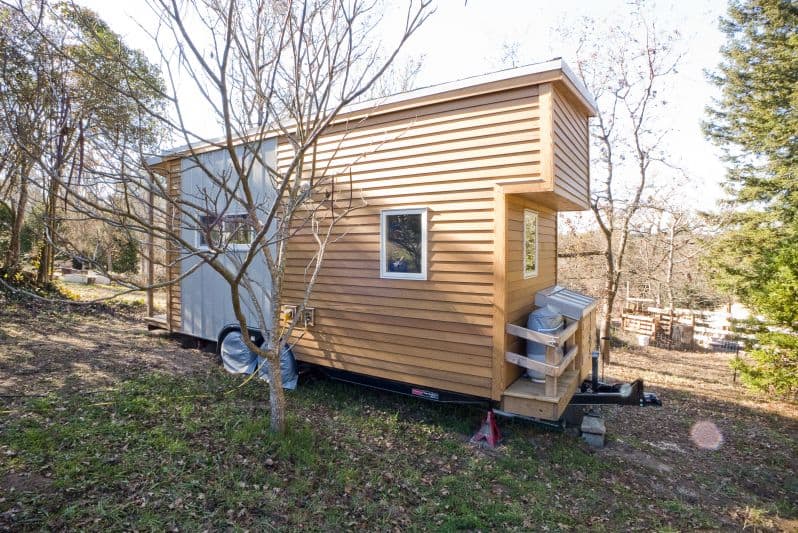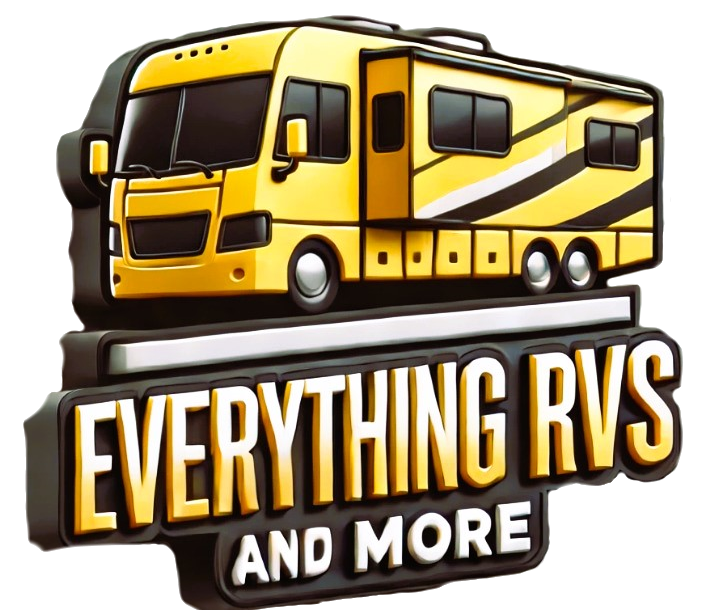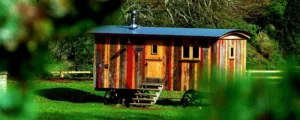Affiliate Disclosure: I earn commissions if you shop through the links below at no additional cost to you.
Last Updated on March 1, 2025 by Jeremy
You’re ready for the next phase of your lifestyle. You’ve lived the full-time RV life, enjoyed the open road, and embraced simplicity. But now, something’s missing. Maybe you need more space, better customization, or simply a fresh take on minimal living.
What if instead of upgrading to a bigger RV, you went smaller but smarter?
Let’s explore the DIY tiny house movement—a logical step for RVers who want the freedom of mobility while enjoying the comforts of a custom-built, compact home.

Why Tiny Houses?
Tiny houses have gained massive popularity for good reason. They offer a simpler, more sustainable lifestyle while keeping the costs of homeownership low.
For full-time RVers, the transition to a tiny home is a natural fit. You’re already accustomed to downsized living, off-grid setups, and mobile-friendly designs—making tiny house living an easy adjustment.
Top Reasons to Consider a Tiny House:
- More Space, But Still Compact – A tiny house feels bigger than an RV but still maintains a minimalist footprint.
- Lower Living Costs – Fewer utilities, cheaper maintenance, and no RV park fees.
- Custom-Built for Your Needs – No more dealing with pre-designed RV layouts that don’t fit your lifestyle.
- Off-Grid Friendly – Solar power, rainwater collection, composting toilets, and propane heating all work perfectly.
- No Depreciation – Unlike an RV, a tiny home holds its value, or even appreciates over time.
Plus, many tiny homes are built on wheels, meaning you can stay mobile just like an RV, but with better insulation, sturdier materials, and long-term livability.
How Tiny Homes Compare to RVs
| Feature | RV | Tiny House |
|---|---|---|
| Size | 100-400 sq ft | 100-600 sq ft |
| Insulation | Minimal, designed for short-term use | Built for year-round living |
| Mobility | Easily towable | Towable but heavier |
| Customization | Limited | Fully customizable |
| Lifespan | 10-15 years | 30+ years |
| Depreciation | Rapid | Holds value |
| Off-Grid Capabilities | Solar panels, propane | Solar, rain collection, wood stoves |
If you’re tired of the constant maintenance and depreciation of RVs, a tiny house is a long-term investment that can serve as a permanent home or mobile retreat.
Building a Tiny House: DIY vs. Manufactured
You have two options when it comes to your tiny house:
- Buy a manufactured tiny home – Professionally built, ready to move in.
- DIY your tiny house – Cost-effective, fully customized, and built exactly the way you want it.
For those who love building, designing, and saving money, the DIY route is an excellent choice.
Cost Breakdown: DIY Tiny House vs. Pre-Built
| Cost Factor | DIY Build | Pre-Built |
|---|---|---|
| Base Cost | $10,000 – $50,000 | $50,000 – $150,000 |
| Customization | Full control | Limited |
| Time Investment | 3-12 months | Immediate |
| Skill Level Required | Moderate to high | None |
With a DIY approach, you can build a functional, off-grid-ready tiny home for as little as $10,000–$20,000, whereas manufactured homes start at $50,000+.
The decision ultimately depends on your skills, budget, and how hands-on you want to be.
DIY Tiny House Plans – The Best Options for Building Your Own
1. Craftsman Tiny Homes – Custom-Built Perfection
Best for: People who want complete control over their tiny house design.
Craftsman Tiny Homes specializes in tailored designs, allowing you to create a home that perfectly fits your lifestyle. Their plans focus on maximizing space, energy efficiency, and off-grid capabilities.
Highlights:
- Choose from pre-made plans or fully custom designs.
- Offers guidance for first-time builders.
- Can be adapted for trailers, foundation homes, or container builds.
This is ideal if you want a long-lasting, well-designed tiny house without the limitations of cookie-cutter layouts.
2. The Tiny Project – Modern Design & Functionality
Best for: DIYers who want sleek, modern aesthetics with easy-to-follow construction plans.
The Tiny Project provides detailed blueprints and materials lists to help you construct a modern, energy-efficient tiny house.
What’s Included:
- Step-by-step instructions for all aspects of construction.
- Guides for insulation, electrical, and plumbing systems.
- Towing, framing, and internet setup recommendations.
This is a great choice if you want a high-end look but still want to build it yourself.
Check Out The Tiny Project Plans
3. Humble Homes – A Variety of Tiny House Styles
Best for: People who want multiple design options and pro-level construction plans.
With over 21 different plans, Humble Homes provides flexibility for different lifestyles and budgets.
Notable Features:
- Plans filtered by budget, square footage, and roof style.
- Options for modular tiny houses.
- Specializes in off-grid living solutions.
One standout model is “The Turtle”—a small, durable home designed for both mobility and full-time living.
Essential Interior Systems for a DIY Tiny House
Once the exterior is built, the next step is outfitting the interior with efficient systems.
Key Systems to Consider:
| System | Options |
|---|---|
| Toilets | Composting, incinerating, or traditional flush |
| Power | Solar panels, battery banks, propane |
| Water | Rain collection, well water, or standard hookup |
| Heating & Cooling | Mini-split AC, wood stoves, propane heaters |
Each of these plays a crucial role in making your tiny home fully functional and self-sufficient.
Final Thoughts
Transitioning from full-time RV living to a DIY tiny house is a smart, practical move that gives you:
- More space without sacrificing mobility.
- A fully customized living environment.
- A long-term home that doesn’t depreciate like an RV.
Whether you choose Craftsman Tiny Homes, The Tiny Project, or Humble Homes, each offers a path to building your dream tiny house on your terms.
Your next adventure starts with one swing of a hammer at a time.




.jpg/:/cr=t:5.56%25,l:0%25,w:100%25,h:88.89%25/rs=w:1240,h:620,cg:true)



Leave a Reply